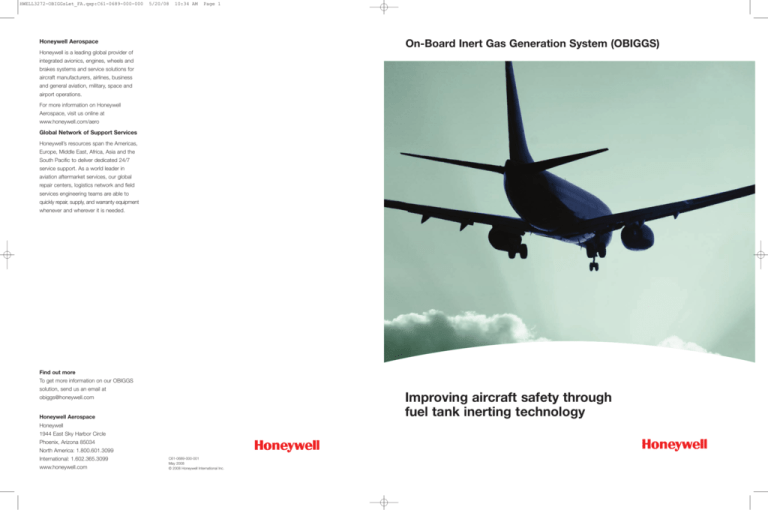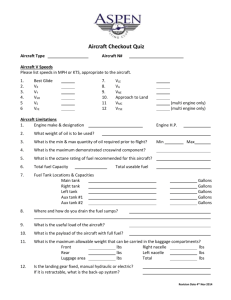Improving aircraft safety through fuel tank inerting technology
advertisement

HWELL3272-OBIGGsLet_FA.qxp:C61-0689-000-000 5/20/08 10:34 AM Page 1 On-Board Inert Gas Generation System (OBIGGS) Honeywell Aerospace Honeywell is a leading global provider of integrated avionics, engines, wheels and brakes systems and service solutions for aircraft manufacturers, airlines, business and general aviation, military, space and airport operations. For more information on Honeywell Aerospace, visit us online at www.honeywell.com/aero Global Network of Support Services Honeywell’s resources span the Americas, Europe, Middle East, Africa, Asia and the South Pacific to deliver dedicated 24/7 service support. As a world leader in aviation aftermarket services, our global repair centers, logistics network and field services engineering teams are able to quickly repair, supply, and warranty equipment whenever and wherever it is needed. Find out more To get more information on our OBIGGS solution, send us an email at Improving aircraft safety through fuel tank inerting technology obiggs@honeywell.com Honeywell Aerospace Honeywell 1944 East Sky Harbor Circle Phoenix, Arizona 85034 North America: 1.800.601.3099 International: 1.602.365.3099 www.honeywell.com C61-0689-000-001 May 2008 © 2008 Honeywell International Inc. HWELL3272-OBIGGsLet_FA.qxp:C61-0689-000-000 5/20/08 10:34 AM Page 3 The first FAA-certified commercial air transport system that reduces the probability of fuel tank explosions. Proven solution to cost-effectively enhance commercial aircraft safety The risk of fuel tank explosions has been a The first source is electrical arcing that may occur System Operation Key OBIGGS Components common concern of aircraft manufacturers and if a part of the insulation on the electrical wire The OBIGGS process starts with processed air, The following is a typical list of components airlines since the beginning of commercial flight. bundles that run through the fuel tanks wears off, which is conditioned to optimum pressure and that are used in the fuel tank inerting system: Using advanced fuel tank inerting technologies, exposing a small patch of bare wire, often not temperature and then passed through a series ■ Honeywell has delivered the first FAA-certified visually discernable, that contacts a metal surface. of Air Separation Modules (ASM). The ASMs solution that enhances the safety of commercial Second are friction sparks that can occur from separate the oxygen from the process air through air transport. Our On-Board Inert Gas Generation rotating components, such as a steel fuel pump a permeable gas separation membrane, producing System (OBIGGS) substantially reduces the impeller, rubbing on the pump inlet check valve. primarily nitrogen-enriched air (NEA). The NEA is possibility of ignition of flammable fuel vapors in an aircraft’s fuel tank by lowering the oxygen concentration below the level that will support combustion. The result is safer aircraft operations. There are three major causes of fuel tank The final source is auto ignition, where combustion can occur when the fuel/air mixture spontaneously ignites from heat; even in the absence of an delivered to the fuel tank where it displaces the ■ Heat exchanger to condition the temperature ■ High efficiency ozone converter to ensure ■ Thermal Control Unit (TCU) or one that is explosions as noted by the FAA*. All of which ■ Low air flow consumption ensures minimal fuel-burn impact ■ Extensive database of component design data to ensure high component reliability ■ State-of-the-art oxygen sensing equipment ■ Full development and test facilities to ensure system operability and technology readiness ■ Over 50 years of systems engineering and integration of complex mechanical and pneumatic aircraft systems ■ Global support network to meet all product support needs Valves used to control NEA distribution and ■ Pressure, temperature and oxygen sensors (ECS), along with the Air Separation Unit (ASU) ■ Contaminant filter and instrumentation to control the operation ■ Air separation modules ■ Honeywell digital controller with full and distribution of air to the fuel tanks. ■ Turbo compressor to condition the pressure flow modes integrated with the Environmental Control System are reduced by OBIGGS. Integrated with existing ECS to ensure minimal aircraft impact (not required for all applications) The system consists of either an independent ignition source. ■ long ASM life flammable fuel/air mixture to reduce the risk of an explosion or fire. Pressure regulating and shut-off valve Key OBIGGS Advantages built-in-test display Leading Technologies Thermal Control Unit OEA NEA Nitrogen Enriched Air (NEA) delivered to the fuel tanks Air Separation Unit Temperature control valve Check valve As a leading systems integrator, Honeywell is responsible for the overall design, performance and integration of our fuel tank inerting systems and has formed industry partnerships to ensure the best technologies are incorporated into our OBIGGS solutions. Our fuel tank inerting Fan Preconditioned air from the thermal control unit aircraft since 2005 for an in-service evaluation and have accumulated over 20,000 flight hours Oxygen Enriched Air (OEA) is vented overboard Heat exchanger Permeable membrane separates oxygen from the process air *FAA Initial Regulatory Evaluation – Fuel Tank Flammability Reduction Report technologies have been installed on select Ozone converter of proven operation.








